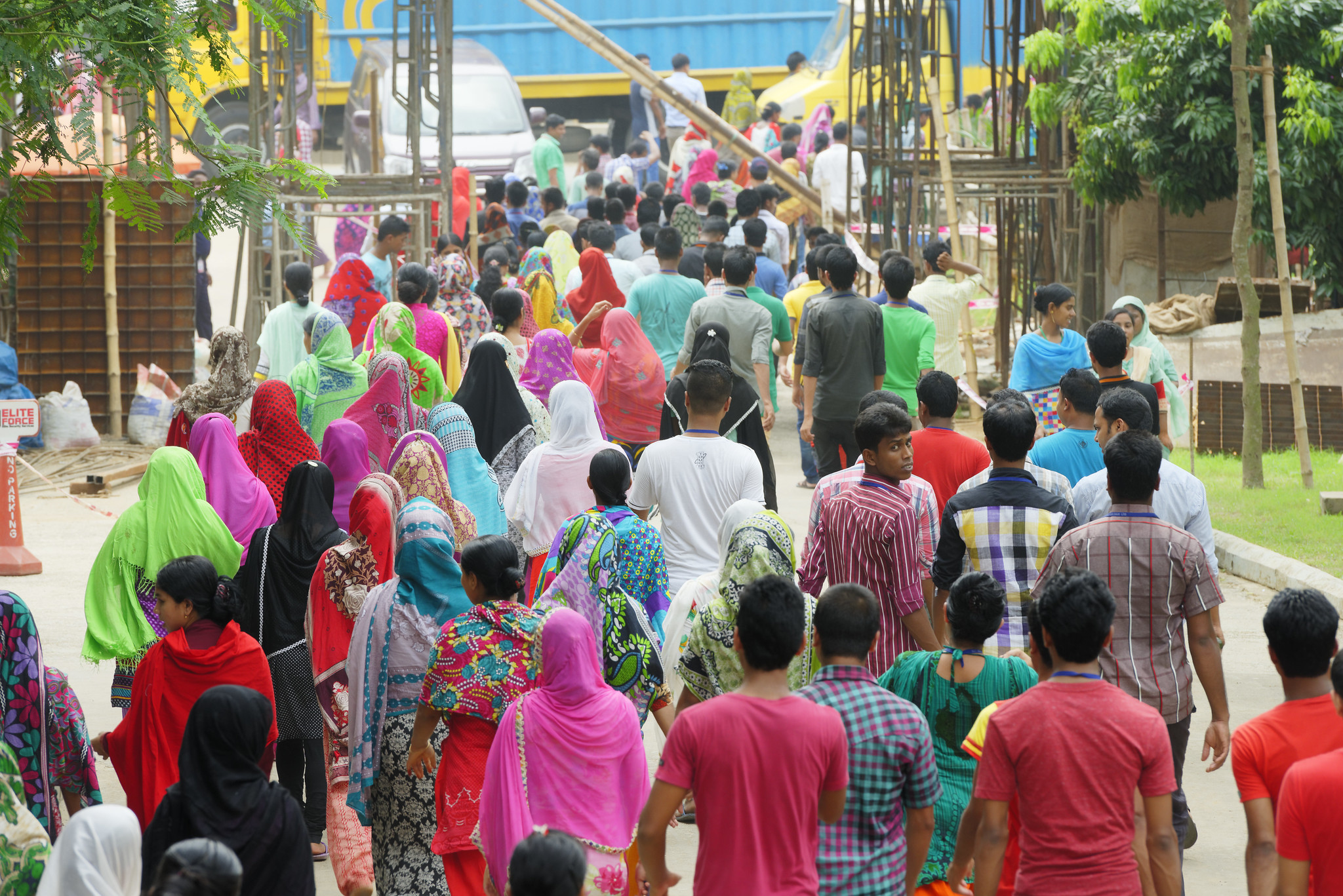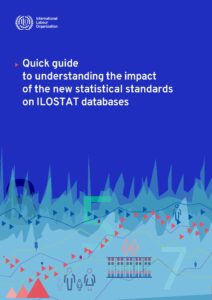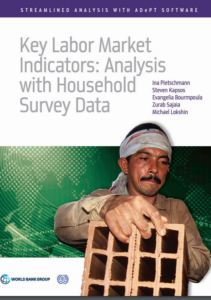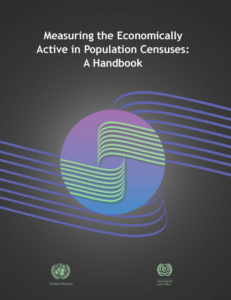Índice de contenidos
Introducción
La población en edad de trabajar es un concepto central en las estadísticas laborales. Los cambios en el tamaño de la población en edad de trabajar pueden tener un impacto significativo en el mercado laboral y en la economía. Una población en edad de trabajar en aumento ofrece oportunidades de crecimiento económico y, al mismo tiempo, plantea retos para la creación de empleo y la integración de los nuevos participantes en el mercado laboral. Por el contrario, una disminución de la población en edad de trabajar puede crear desafíos para el crecimiento económico, la competitividad, la dependencia de la población, etc.
Sin embargo, no todas las personas que forman parte de la población en edad de trabajar participan activamente en el mercado laboral. Algunos tienen trabajo, otros buscan trabajo, otros se desalientan, se dedican únicamente a otras actividades o no están interesados en el mercado laboral. Se necesitan estadísticas que nos permitan comprender cómo se relacionan las personas con el mercado laboral y cómo éste cambia con el tiempo. Estas estadísticas requieren definiciones claras para garantizar la coherencia y la claridad de la medición, la información y la interpretación. Tal y como se define en las normas internacionales (19a CIET de diciembre de 2013), la población activa está formada por las personas en edad de trabajar que participan activamente en el mercado de trabajo. Es la suma de las personas empleadas y los desempleados. En conjunto, estos dos grupos de población en edad de trabajar representan la oferta de mano de obra para la producción de bienes y servicios a cambio de la remuneración que existe en un país en un momento dado.
Entre los indicadores clave para el seguimiento de la población en edad de trabajar y de la población activa figuran la relación la ocupación-población, la tasa de actividad y los coeficientes de dependencia por edad. Se trata de indicadores principales esenciales del mercado de trabajo que deben complementarse con otros indicadores, como las medidas de la subutilización de la fuerza de trabajo para el seguimiento y la elaboración de políticas.
Catálogo de datos
| Indicador | Frecuencia | Base de datos | Asunto | Descargar (con etiquetas) | Descargar (con códigos) | Explorador de datos |
|---|---|---|---|---|---|---|
| Población en edad de trabajar según sexo y edad (miles) | Anual | Estadísticas sobre la Fuerza Laboral (EPA) | Población | .csv .dta .xlsx | .csv.gz | |
| Población en edad de trabajar según sexo y edad (miles) | Trimestral | Estadísticas de la Fuerza Laboral a Corto Plazo (STLFS) | Población | .csv .dta .xlsx | .csv.gz | |
| Población en edad de trabajar según sexo y edad (miles) | Mensual | Estadísticas de la Fuerza Laboral a Corto Plazo (STLFS) | Población | .csv .dta .xlsx | .csv.gz | |
| Población en edad de trabajar según sexo, edad y educación (miles) | Anual | Indicadores de Educación y Desajuste (EMI) | Población | .csv .dta | .csv.gz | |
| Población en edad de trabajar según sexo, edad y educación (miles) | Trimestral | Estadísticas de la Fuerza Laboral a Corto Plazo (STLFS) | Población | .csv .dta | .csv.gz | |
| Población en edad de trabajar según sexo, edad y educación (miles) | Mensual | Estadísticas de la Fuerza Laboral a Corto Plazo (STLFS) | Población | .csv .dta .xlsx | .csv.gz | |
| Población en edad de trabajar según sexo, edad y zonas rurales / urbanas (miles) | Anual | Mercados Laborales Rurales y Urbanos (RURBAN) | Población | .csv .dta .xlsx | .csv.gz | |
| Población en edad de trabajar según sexo, edad y zonas rurales / urbanas (miles) | Trimestral | Estadísticas de la Fuerza Laboral a Corto Plazo (STLFS) | Población | .csv .dta .xlsx | .csv.gz | |
| Población en edad de trabajar según sexo, edad y zonas rurales / urbanas (miles) | Mensual | Estadísticas de la Fuerza Laboral a Corto Plazo (STLFS) | Población | .csv .dta .xlsx | .csv.gz | |
| Poblacion en edad de trabajar según sexo, edad y estado civil (miles) | Anual | Indicadores de Igualdad de Género y No Discriminación (GEND) | Población | .csv .dta .xlsx | .csv.gz | |
| Poblacion en edad de trabajar según sexo, edad y estado civil (miles) | Trimestral | Estadísticas de la Fuerza Laboral a Corto Plazo (STLFS) | Población | .csv .dta | .csv.gz | |
| Población en edad de trabajar según sexo, edad y situación en términos de discapacidad (miles) | Anual | Indicadores del mercado laboral de la discapacidad | Población | .csv .dta .xlsx | .csv.gz | |
| Población en edad de trabajar según sexo, edad y situación en el mercado de (miles) | Anual | Estadísticas sobre la Fuerza Laboral (EPA) | Población | .csv .dta .xlsx | .csv.gz | |
| Población en edad de trabajar según sexo, edad y situación en el mercado de (miles) | Trimestral | Estadísticas de la Fuerza Laboral a Corto Plazo (STLFS) | Población | .csv .dta | .csv.gz | |
| Población en edad de trabajar según sexo, edad y situación en el mercado de (miles) | Mensual | Estadísticas de la Fuerza Laboral a Corto Plazo (STLFS) | Población | .csv .dta .xlsx | .csv.gz | |
| Población en edad de trabajar según sexo y educación (miles) | Anual | Indicadores de Educación y Desajuste (EMI) | Población | .csv .dta .xlsx | .csv.gz | |
| Población en edad de trabajar según sexo y educación (miles) | Trimestral | Estadísticas de la Fuerza Laboral a Corto Plazo (STLFS) | Población | .csv .dta .xlsx | .csv.gz | |
| Población en edad de trabajar según sexo y educación (miles) | Mensual | Estadísticas de la Fuerza Laboral a Corto Plazo (STLFS) | Población | .csv .dta .xlsx | .csv.gz | |
| Población en edad de trabajar según sexo, educación y zonas rurales / urbanas (miles) | Anual | Indicadores de Educación y Desajuste (EMI) | Población | .csv .dta .xlsx | .csv.gz | |
| Población en edad de trabajar según sexo, educación y zonas rurales / urbanas (miles) | Trimestral | Estadísticas de la Fuerza Laboral a Corto Plazo (STLFS) | Población | .csv .dta .xlsx | .csv.gz | |
| Población en edad de trabajar según sexo, educación y estado civil (miles) | Anual | Indicadores de Educación y Desajuste (EMI) | Población | .csv .dta .xlsx | .csv.gz | |
| Población en edad de trabajar según sexo, educación y estado civil (miles) | Trimestral | Estadísticas de la Fuerza Laboral a Corto Plazo (STLFS) | Población | .csv .dta .xlsx | .csv.gz | |
| Población en edad de trabajar según sexo, educación y situación en términos de discapacidad (miles) | Anual | Indicadores del mercado laboral de la discapacidad | Población | .csv .dta .xlsx | .csv.gz | |
| Población en edad de trabajar según sexo, educación y situación en el mercado de trabajo (miles) | Anual | Indicadores de Educación y Desajuste (EMI) | Población | .csv .dta .xlsx | .csv.gz | |
| Población en edad de trabajar según sexo, educación y situación en el mercado de trabajo (miles) | Trimestral | Estadísticas de la Fuerza Laboral a Corto Plazo (STLFS) | Población | .csv .dta .xlsx | .csv.gz | |
| Población en edad de trabajar según sexo, educación y situación en el mercado de trabajo (miles) | Mensual | Estadísticas de la Fuerza Laboral a Corto Plazo (STLFS) | Población | .csv .dta .xlsx | .csv.gz | |
| Población en edad de trabajar según sexo y zonas rurales / urbanas (miles) | Anual | Mercados Laborales Rurales y Urbanos (RURBAN) | Población | .csv .dta .xlsx | .csv.gz | |
| Población en edad de trabajar según sexo y zonas rurales / urbanas (miles) | Trimestral | Estadísticas de la Fuerza Laboral a Corto Plazo (STLFS) | Población | .csv .dta .xlsx | .csv.gz | |
| Población en edad de trabajar según sexo y zonas rurales / urbanas (miles) | Mensual | Estadísticas de la Fuerza Laboral a Corto Plazo (STLFS) | Población | .csv .dta .xlsx | .csv.gz | |
| Población en edad de trabajar según sexo, zonas rurales / urbanas y estado civil (miles) | Anual | Mercados Laborales Rurales y Urbanos (RURBAN) | Población | .csv .dta .xlsx | .csv.gz | |
| Población en edad de trabajar según sexo, zonas rurales / urbanas y estado civil (miles) | Trimestral | Estadísticas de la Fuerza Laboral a Corto Plazo (STLFS) | Población | .csv .dta .xlsx | .csv.gz | |
| Población en edad de trabajar según sexo, zonas rurales / urbanas y situación en términos de discapacidad (miles) | Anual | Indicadores del mercado laboral de la discapacidad | Población | .csv .dta .xlsx | .csv.gz | |
| Población en edad de trabajar según sexo, zonas rurales / urbanas y situación en términos de discapacidad (miles) | Trimestral | Estadísticas de la Fuerza Laboral a Corto Plazo (STLFS) | Población | .csv .dta .xlsx | .csv.gz | |
| Población en edad de trabajar según sexo, zonas rurales / urbanas y situación en el mercado de trabajo (miles) | Anual | Mercados Laborales Rurales y Urbanos (RURBAN) | Población | .csv .dta .xlsx | .csv.gz | |
| Población en edad de trabajar según sexo, zonas rurales / urbanas y situación en el mercado de trabajo (miles) | Trimestral | Estadísticas de la Fuerza Laboral a Corto Plazo (STLFS) | Población | .csv .dta .xlsx | .csv.gz | |
| Población en edad de trabajar según sexo, zonas rurales / urbanas y situación en el mercado de trabajo (miles) | Mensual | Estadísticas de la Fuerza Laboral a Corto Plazo (STLFS) | Población | .csv .dta .xlsx | .csv.gz | |
| Poblacion en edad de trabajar según sexo y estado civil (miles) | Anual | Indicadores de Igualdad de Género y No Discriminación (GEND) | Población | .csv .dta .xlsx | .csv.gz | |
| Poblacion en edad de trabajar según sexo y estado civil (miles) | Trimestral | Estadísticas de la Fuerza Laboral a Corto Plazo (STLFS) | Población | .csv .dta .xlsx | .csv.gz | |
| Poblacion en edad de trabajar según sexo y estado civil (miles) | Mensual | Estadísticas de la Fuerza Laboral a Corto Plazo (STLFS) | Población | .csv .dta .xlsx | .csv.gz | |
| Población en edad de trabajar según sexo, estado civil y situación en términos de discapacidad (miles) | Anual | Indicadores del mercado laboral de la discapacidad | Población | .csv .dta .xlsx | .csv.gz | |
| Población en edad de trabajar según sexo, estado civil y situación en términos de discapacidad (miles) | Trimestral | Estadísticas de la Fuerza Laboral a Corto Plazo (STLFS) | Población | .csv .dta .xlsx | .csv.gz | |
| Población en edad de trabajar según sexo, estado civil y situación en el mercado de trabajo (miles) | Anual | Indicadores de Igualdad de Género y No Discriminación (GEND) | Población | .csv .dta .xlsx | .csv.gz | |
| Población en edad de trabajar según sexo, estado civil y situación en el mercado de trabajo (miles) | Trimestral | Estadísticas de la Fuerza Laboral a Corto Plazo (STLFS) | Población | .csv .dta .xlsx | .csv.gz | |
| Población en edad de trabajar según sexo, estado civil y situación en el mercado de trabajo (miles) | Mensual | Estadísticas de la Fuerza Laboral a Corto Plazo (STLFS) | Población | .csv .dta .xlsx | .csv.gz | |
| Población en edad de trabajar según sexo y situación en términos de discapacidad (miles) | Anual | Indicadores del mercado laboral de la discapacidad | Población | .csv .dta .xlsx | .csv.gz | |
| Población en edad de trabajar según sexo y situación en términos de discapacidad (miles) | Trimestral | Estadísticas de la Fuerza Laboral a Corto Plazo (STLFS) | Población | .csv .dta .xlsx | .csv.gz | |
| Población en edad de trabajar según sexo, situación en términos de discapacidad y situación en el mercado de trabajo (miles) | Anual | Indicadores del mercado laboral de la discapacidad | Población | .csv .dta .xlsx | .csv.gz | |
| Población en edad de trabajar según sexo, situación en términos de discapacidad y situación en el mercado de trabajo (miles) | Trimestral | Estadísticas de la Fuerza Laboral a Corto Plazo (STLFS) | Población | .csv .dta .xlsx | .csv.gz | |
| Población en edad de trabajar según sexo y situación en el mercado de trabajo (miles) | Anual | Estadísticas sobre la Fuerza Laboral (EPA) | Población | .csv .dta .xlsx | .csv.gz | |
| Población en edad de trabajar según sexo y situación en el mercado de trabajo (miles) | Trimestral | Estadísticas de la Fuerza Laboral a Corto Plazo (STLFS) | Población | .csv .dta .xlsx | .csv.gz | |
| Población en edad de trabajar según sexo y situación en el mercado de trabajo (miles) | Mensual | Estadísticas de la Fuerza Laboral a Corto Plazo (STLFS) | Población | .csv .dta .xlsx | .csv.gz | |
| Población de edad de 25 a 54 años según tipo de hogar (miles) | Anual | Indicadores de Igualdad de Género y No Discriminación (GEND) | Población | .csv .dta .xlsx | .csv.gz | |
| Fuerza de trabajo según sexo y edad (miles) | Anual | Estadísticas sobre la Fuerza Laboral (EPA) | Fuerza de trabajo | .csv .dta .xlsx | .csv.gz | |
| Fuerza de trabajo según sexo y edad (miles) | Trimestral | Estadísticas de la Fuerza Laboral a Corto Plazo (STLFS) | Fuerza de trabajo | .csv .dta .xlsx | .csv.gz | |
| Fuerza de trabajo según sexo y edad (miles) | Mensual | Estadísticas de la Fuerza Laboral a Corto Plazo (STLFS) | Fuerza de trabajo | .csv .dta .xlsx | .csv.gz | |
| Fuerza de trabajo según sexo, edad y educación (miles) | Anual | Indicadores de Educación y Desajuste (EMI) | Fuerza de trabajo | .csv .dta | .csv.gz | |
| Fuerza de trabajo según sexo, edad y educación (miles) | Trimestral | Estadísticas de la Fuerza Laboral a Corto Plazo (STLFS) | Fuerza de trabajo | .csv .dta | .csv.gz | |
| Fuerza de trabajo según sexo, edad y educación (miles) | Mensual | Estadísticas de la Fuerza Laboral a Corto Plazo (STLFS) | Fuerza de trabajo | .csv .dta .xlsx | .csv.gz | |
| Fuerza de trabajo según sexo, edad y zonas rurales / urbanas (millas) | Anual | Mercados Laborales Rurales y Urbanos (RURBAN) | Fuerza de trabajo | .csv .dta .xlsx | .csv.gz | |
| Fuerza de trabajo según sexo, edad y zonas rurales / urbanas (millas) | Trimestral | Estadísticas de la Fuerza Laboral a Corto Plazo (STLFS) | Fuerza de trabajo | .csv .dta .xlsx | .csv.gz | |
| Fuerza de trabajo según sexo, edad y zonas rurales / urbanas (millas) | Mensual | Estadísticas de la Fuerza Laboral a Corto Plazo (STLFS) | Fuerza de trabajo | .csv .dta .xlsx | .csv.gz | |
| Fuerza de trabajo según sexo, edad y estado civil (miles) | Anual | Indicadores de Igualdad de Género y No Discriminación (GEND) | Fuerza de trabajo | .csv .dta .xlsx | .csv.gz | |
| Fuerza de trabajo según sexo, edad y estado civil (miles) | Trimestral | Estadísticas de la Fuerza Laboral a Corto Plazo (STLFS) | Fuerza de trabajo | .csv .dta | .csv.gz | |
| Fuerza de trabajo según sexo, edad y situación en términos de discapacidad (miles) | Anual | Indicadores del mercado laboral de la discapacidad | Fuerza de trabajo | .csv .dta .xlsx | .csv.gz | |
| Fuerza de trabajo según sexo y educación (miles) | Anual | Indicadores de Educación y Desajuste (EMI) | Fuerza de trabajo | .csv .dta .xlsx | .csv.gz | |
| Fuerza de trabajo según sexo y educación (miles) | Trimestral | Estadísticas de la Fuerza Laboral a Corto Plazo (STLFS) | Fuerza de trabajo | .csv .dta .xlsx | .csv.gz | |
| Fuerza de trabajo según sexo y educación (miles) | Mensual | Estadísticas de la Fuerza Laboral a Corto Plazo (STLFS) | Fuerza de trabajo | .csv .dta .xlsx | .csv.gz | |
| Fuerza de trabajo según sexo, educación y áreas rurales / urbanas (millas) | Anual | Indicadores de Educación y Desajuste (EMI) | Fuerza de trabajo | .csv .dta .xlsx | .csv.gz | |
| Fuerza de trabajo según sexo, educación y áreas rurales / urbanas (millas) | Trimestral | Estadísticas de la Fuerza Laboral a Corto Plazo (STLFS) | Fuerza de trabajo | .csv .dta .xlsx | .csv.gz | |
| Fuerza de trabajo según sexo, educación y estado civil (miles) | Anual | Indicadores de Educación y Desajuste (EMI) | Fuerza de trabajo | .csv .dta .xlsx | .csv.gz | |
| Fuerza de trabajo según sexo, educación y estado civil (miles) | Trimestral | Estadísticas de la Fuerza Laboral a Corto Plazo (STLFS) | Fuerza de trabajo | .csv .dta .xlsx | .csv.gz | |
| Fuerza de trabajo según sexo, educación y situación en términos de discapacidad (miles) | Anual | Indicadores del mercado laboral de la discapacidad | Fuerza de trabajo | .csv .dta .xlsx | .csv.gz | |
| Fuerza de trabajo según sexo y zonas rurales / urbanas (millas) | Anual | Mercados Laborales Rurales y Urbanos (RURBAN) | Fuerza de trabajo | .csv .dta .xlsx | .csv.gz | |
| Fuerza de trabajo según sexo y zonas rurales / urbanas (millas) | Trimestral | Estadísticas de la Fuerza Laboral a Corto Plazo (STLFS) | Fuerza de trabajo | .csv .dta .xlsx | .csv.gz | |
| Fuerza de trabajo según sexo y zonas rurales / urbanas (millas) | Mensual | Estadísticas de la Fuerza Laboral a Corto Plazo (STLFS) | Fuerza de trabajo | .csv .dta .xlsx | .csv.gz | |
| Fuerza de trabajo según sexo, zonas rurales / urbanas y estado civil (miles) | Anual | Mercados Laborales Rurales y Urbanos (RURBAN) | Fuerza de trabajo | .csv .dta .xlsx | .csv.gz | |
| Fuerza de trabajo según sexo, zonas rurales / urbanas y estado civil (miles) | Trimestral | Estadísticas de la Fuerza Laboral a Corto Plazo (STLFS) | Fuerza de trabajo | .csv .dta .xlsx | .csv.gz | |
| Fuerza de trabajo según sexo, zonas rurales / urbanas y situación en términos de discapacidad (miles) | Anual | Indicadores del mercado laboral de la discapacidad | Fuerza de trabajo | .csv .dta .xlsx | .csv.gz | |
| Fuerza de trabajo según sexo, zonas rurales / urbanas y situación en términos de discapacidad (miles) | Trimestral | Estadísticas de la Fuerza Laboral a Corto Plazo (STLFS) | Fuerza de trabajo | .csv .dta .xlsx | .csv.gz | |
| Fuerza de trabajo según sexo y estado civil (miles) | Anual | Indicadores de Igualdad de Género y No Discriminación (GEND) | Fuerza de trabajo | .csv .dta .xlsx | .csv.gz | |
| Fuerza de trabajo según sexo y estado civil (miles) | Trimestral | Estadísticas de la Fuerza Laboral a Corto Plazo (STLFS) | Fuerza de trabajo | .csv .dta .xlsx | .csv.gz | |
| Fuerza de trabajo según sexo y estado civil (miles) | Mensual | Estadísticas de la Fuerza Laboral a Corto Plazo (STLFS) | Fuerza de trabajo | .csv .dta .xlsx | .csv.gz | |
| Fuerza de trabajo según sexo, estado civil y situación en términos de discapacidad (miles) | Anual | Indicadores del mercado laboral de la discapacidad | Fuerza de trabajo | .csv .dta .xlsx | .csv.gz | |
| Fuerza de trabajo según sexo, estado civil y situación en términos de discapacidad (miles) | Trimestral | Estadísticas de la Fuerza Laboral a Corto Plazo (STLFS) | Fuerza de trabajo | .csv .dta .xlsx | .csv.gz | |
| Fuerza de trabajo según sexo y situación en términos de discapacidad (miles) | Anual | Indicadores del mercado laboral de la discapacidad | Fuerza de trabajo | .csv .dta .xlsx | .csv.gz | |
| Fuerza de trabajo según sexo y situación en términos de discapacidad (miles) | Trimestral | Estadísticas de la Fuerza Laboral a Corto Plazo (STLFS) | Fuerza de trabajo | .csv .dta .xlsx | .csv.gz | |
| Fuerza de trabajo según sexo y edad, series desestacionalizadas (miles) | Trimestral | Estadísticas de la Fuerza Laboral a Corto Plazo (STLFS) | Fuerza de trabajo | .csv .dta .xlsx | .csv.gz | |
| Fuerza de trabajo según sexo y edad, series desestacionalizadas (miles) | Mensual | Estadísticas de la Fuerza Laboral a Corto Plazo (STLFS) | Fuerza de trabajo | .csv .dta .xlsx | .csv.gz | |
| Tasa de participación en la fuerza de trabajo según sexo y edad (%) | Anual | Estadísticas sobre la Fuerza Laboral (EPA) | Fuerza de trabajo | .csv .dta .xlsx | .csv.gz | |
| Tasa de participación en la fuerza de trabajo según sexo y edad (%) | Trimestral | Estadísticas de la Fuerza Laboral a Corto Plazo (STLFS) | Fuerza de trabajo | .csv .dta .xlsx | .csv.gz | |
| Tasa de participación en la fuerza de trabajo según sexo y edad (%) | Mensual | Estadísticas de la Fuerza Laboral a Corto Plazo (STLFS) | Fuerza de trabajo | .csv .dta .xlsx | .csv.gz | |
| Tasa de participación en la fuerza de trabajo según sexo, edad y educación (%) | Anual | Indicadores de Educación y Desajuste (EMI) | Fuerza de trabajo | .csv .dta | .csv.gz | |
| Tasa de participación en la fuerza de trabajo según sexo, edad y educación (%) | Trimestral | Estadísticas de la Fuerza Laboral a Corto Plazo (STLFS) | Fuerza de trabajo | .csv .dta | .csv.gz | |
| Tasa de participación en la fuerza de trabajo según sexo, edad y educación (%) | Mensual | Estadísticas de la Fuerza Laboral a Corto Plazo (STLFS) | Fuerza de trabajo | .csv .dta .xlsx | .csv.gz | |
| Tasa de participación en la fuerza de trabajo según sexo, edad y zonas rurales / urbanas (%) | Anual | Mercados Laborales Rurales y Urbanos (RURBAN) | Fuerza de trabajo | .csv .dta .xlsx | .csv.gz | |
| Tasa de participación en la fuerza de trabajo según sexo, edad y zonas rurales / urbanas (%) | Trimestral | Estadísticas de la Fuerza Laboral a Corto Plazo (STLFS) | Fuerza de trabajo | .csv .dta .xlsx | .csv.gz | |
| Tasa de participación en la fuerza de trabajo según sexo, edad y zonas rurales / urbanas (%) | Mensual | Estadísticas de la Fuerza Laboral a Corto Plazo (STLFS) | Fuerza de trabajo | .csv .dta .xlsx | .csv.gz | |
| Tasa de participación en la fuerza de trabajo según sexo y estado civil (%) | Anual | Indicadores de Igualdad de Género y No Discriminación (GEND) | Fuerza de trabajo | .csv .dta .xlsx | .csv.gz | |
| Tasa de participación en la fuerza de trabajo según sexo y estado civil (%) | Trimestral | Estadísticas de la Fuerza Laboral a Corto Plazo (STLFS) | Fuerza de trabajo | .csv .dta | .csv.gz | |
| Tasa de participación en la fuerza de trabajo según sexo, edad y situación en términos de discapacidad (%) | Anual | Indicadores del mercado laboral de la discapacidad | Fuerza de trabajo | .csv .dta .xlsx | .csv.gz | |
| Tasa de participación en la fuerza de trabajo según sexo y educación (%) | Anual | Indicadores de Educación y Desajuste (EMI) | Fuerza de trabajo | .csv .dta .xlsx | .csv.gz | |
| Tasa de participación en la fuerza de trabajo según sexo y educación (%) | Trimestral | Estadísticas de la Fuerza Laboral a Corto Plazo (STLFS) | Fuerza de trabajo | .csv .dta .xlsx | .csv.gz | |
| Tasa de participación en la fuerza de trabajo según sexo y educación (%) | Mensual | Estadísticas de la Fuerza Laboral a Corto Plazo (STLFS) | Fuerza de trabajo | .csv .dta .xlsx | .csv.gz | |
| Tasa de participación en la fuerza de trabajo según sexo, educación y áreas rurales / urbanas (%) | Anual | Indicadores de Educación y Desajuste (EMI) | Fuerza de trabajo | .csv .dta .xlsx | .csv.gz | |
| Tasa de participación en la fuerza de trabajo según sexo, educación y áreas rurales / urbanas (%) | Trimestral | Estadísticas de la Fuerza Laboral a Corto Plazo (STLFS) | Fuerza de trabajo | .csv .dta .xlsx | .csv.gz | |
| Tasa de participación en la fuerza de trabajo según sexo, educación y estado civil (%) | Anual | Indicadores de Educación y Desajuste (EMI) | Fuerza de trabajo | .csv .dta .xlsx | .csv.gz | |
| Tasa de participación en la fuerza de trabajo según sexo, educación y situación en términos de discapacidad (%) | Anual | Indicadores del mercado laboral de la discapacidad | Fuerza de trabajo | .csv .dta .xlsx | .csv.gz | |
| Tasa de participación en la fuerza de trabajo según sexo y zonas rurales / urbanas (%) | Anual | Mercados Laborales Rurales y Urbanos (RURBAN) | Fuerza de trabajo | .csv .dta .xlsx | .csv.gz | |
| Tasa de participación en la fuerza de trabajo según sexo y zonas rurales / urbanas (%) | Trimestral | Estadísticas de la Fuerza Laboral a Corto Plazo (STLFS) | Fuerza de trabajo | .csv .dta .xlsx | .csv.gz | |
| Tasa de participación en la fuerza de trabajo según sexo y zonas rurales / urbanas (%) | Mensual | Estadísticas de la Fuerza Laboral a Corto Plazo (STLFS) | Fuerza de trabajo | .csv .dta .xlsx | .csv.gz | |
| Tasa de participación en la fuerza de trabajo según sexo, zonas rurales / urbanas y estado civil (%) | Anual | Mercados Laborales Rurales y Urbanos (RURBAN) | Fuerza de trabajo | .csv .dta .xlsx | .csv.gz | |
| Tasa de participación en la fuerza de trabajo según sexo, zonas rurales / urbanas y estado civil (%) | Trimestral | Estadísticas de la Fuerza Laboral a Corto Plazo (STLFS) | Fuerza de trabajo | .csv .dta .xlsx | .csv.gz | |
| Tasa de participación en la fuerza de trabajo según sexo, zonas rurales / urbanas y situación en términos de discapacidad (%) | Anual | Indicadores del mercado laboral de la discapacidad | Fuerza de trabajo | .csv .dta .xlsx | .csv.gz | |
| Tasa de participación en la fuerza de trabajo según sexo, zonas rurales / urbanas y situación en términos de discapacidad (%) | Trimestral | Estadísticas de la Fuerza Laboral a Corto Plazo (STLFS) | Fuerza de trabajo | .csv .dta .xlsx | .csv.gz | |
| Tasa de participación en la fuerza de trabajo según sexo y estado civil (%) | Anual | Indicadores de Igualdad de Género y No Discriminación (GEND) | Fuerza de trabajo | .csv .dta .xlsx | .csv.gz | |
| Tasa de participación en la fuerza de trabajo según sexo y estado civil (%) | Trimestral | Estadísticas de la Fuerza Laboral a Corto Plazo (STLFS) | Fuerza de trabajo | .csv .dta .xlsx | .csv.gz | |
| Tasa de participación en la fuerza de trabajo según sexo y estado civil (%) | Mensual | Estadísticas de la Fuerza Laboral a Corto Plazo (STLFS) | Fuerza de trabajo | .csv .dta .xlsx | .csv.gz | |
| Tasa de participación en la fuerza de trabajo según sexo, estado civil y situación en términos de discapacidad (%) | Anual | Indicadores del mercado laboral de la discapacidad | Fuerza de trabajo | .csv .dta .xlsx | .csv.gz | |
| Tasa de participación en la fuerza de trabajo según sexo, estado civil y situación en términos de discapacidad (%) | Trimestral | Estadísticas de la Fuerza Laboral a Corto Plazo (STLFS) | Fuerza de trabajo | .csv .dta .xlsx | .csv.gz | |
| Tasa de participación en la fuerza de trabajo según sexo y situación en términos de discapacidad (%) | Anual | Indicadores del mercado laboral de la discapacidad | Fuerza de trabajo | .csv .dta .xlsx | .csv.gz | |
| Tasa de participación en la fuerza de trabajo según sexo y situación en términos de discapacidad (%) | Trimestral | Estadísticas de la Fuerza Laboral a Corto Plazo (STLFS) | Fuerza de trabajo | .csv .dta .xlsx | .csv.gz | |
| Tasa de participación en la fuerza de trabajo según sexo y edad, series desestacionalizadas (%) | Trimestral | Estadísticas de la Fuerza Laboral a Corto Plazo (STLFS) | Fuerza de trabajo | .csv .dta .xlsx | .csv.gz | |
| Tasa de participación en la fuerza de trabajo según sexo y edad, series desestacionalizadas (%) | Mensual | Estadísticas de la Fuerza Laboral a Corto Plazo (STLFS) | Fuerza de trabajo | .csv .dta .xlsx | .csv.gz | |
| Tasa de participación en la fuerza de trabajo para personas de 25 a 54 años según sexo, tipo de hogar y zonas rurales / urbanas (%) | Anual | Indicadores de Igualdad de Género y No Discriminación (GEND) | Fuerza de trabajo | .csv .dta .xlsx | .csv.gz | |
| Tasa de participación en la fuerza de trabajo para personas de 25 a 54 años según sexo, tipo de hogar y presencia de niños (%) | Anual | Indicadores de Igualdad de Género y No Discriminación (GEND) | Fuerza de trabajo | .csv .dta .xlsx | .csv.gz | |
| Población juvenil en edad de trabajar según sexo, edad y educación (miles) | Anual | Indicadores del Mercado Laboral Juvenil (YouthSTATS) | Población | .csv .dta .xlsx | .csv.gz | |
| Población juvenil en edad de trabajar según sexo, edad y zonas rurales / urbanas (miles) | Anual | Indicadores del Mercado Laboral Juvenil (YouthSTATS) | Población | .csv .dta .xlsx | .csv.gz | |
| Población juvenil en edad de trabajar según sexo, edad, y estado de la asistencia escolar (miles) | Anual | Indicadores del Mercado Laboral Juvenil (YouthSTATS) | Población | .csv .dta .xlsx | .csv.gz | |
| Población juvenil en edad de trabajar según sexo, edad y situación en términos de discapacidad (miles) | Anual | Indicadores del Mercado Laboral Juvenil (YouthSTATS) | Población | .csv .dta .xlsx | .csv.gz | |
| Población juvenil en edad de trabajar según sexo, edad y situación en el mercado de (miles) | Anual | Indicadores del Mercado Laboral Juvenil (YouthSTATS) | Población | .csv .dta .xlsx | .csv.gz | |
| Población juvenil en edad de trabajar según sexo, edad y etapas de transición (miles) | Anual | Indicadores del Mercado Laboral Juvenil (YouthSTATS) | Población | .csv .dta .xlsx | .csv.gz | |
| Población juvenil en edad de trabajar según sexo, zonas rurales / urbanas y etapas de transición (miles) | Anual | Indicadores del Mercado Laboral Juvenil (YouthSTATS) | Población | .csv .dta .xlsx | .csv.gz | |
| Población juvenil en edad de trabajar según sexo, educación y etapas de transición (miles) | Anual | Indicadores del Mercado Laboral Juvenil (YouthSTATS) | Población | .csv .dta .xlsx | .csv.gz | |
| Población juvenil en edad de trabajar según sexo, edad y formas de transición (miles) | Anual | Indicadores del Mercado Laboral Juvenil (YouthSTATS) | Población | .csv .dta .xlsx | .csv.gz | |
| Población juvenil en edad de trabajar según sexo, zonas rurales / urbanas y formas de transición (miles) | Anual | Indicadores del Mercado Laboral Juvenil (YouthSTATS) | Población | .csv .dta .xlsx | .csv.gz | |
| Población juvenil en edad de trabajar según sexo, educación y formas de transición (miles) | Anual | Indicadores del Mercado Laboral Juvenil (YouthSTATS) | Población | .csv .dta .xlsx | .csv.gz | |
| Fuerza de trabajo juvenil según sexo, edad y educación (miles) | Anual | Indicadores del Mercado Laboral Juvenil (YouthSTATS) | Fuerza de trabajo | .csv .dta .xlsx | .csv.gz | |
| Fuerza de trabajo juvenil por sexo, edad y zonas rurales / urbanas (millas) | Anual | Indicadores del Mercado Laboral Juvenil (YouthSTATS) | Fuerza de trabajo | .csv .dta .xlsx | .csv.gz | |
| Fuerza de trabajo juvenil según sexo, edad y estado de la asistencia escolar (miles) | Anual | Indicadores del Mercado Laboral Juvenil (YouthSTATS) | Fuerza de trabajo | .csv .dta .xlsx | .csv.gz | |
| Fuerza de trabajo juvenil por sexo, edad y situación en términos de discapacidad (miles) | Anual | Indicadores del Mercado Laboral Juvenil (YouthSTATS) | Fuerza de trabajo | .csv .dta .xlsx | .csv.gz | |
| Tasa de participación en la fuerza de trabajo de los jóvenes según sexo, edad y educación (%) | Anual | Indicadores del Mercado Laboral Juvenil (YouthSTATS) | Fuerza de trabajo | .csv .dta .xlsx | .csv.gz | |
| Tasa de participación en la fuerza de trabajo de los jóvenes según sexo, edad y zonas rurales / urbanas (%) | Anual | Indicadores del Mercado Laboral Juvenil (YouthSTATS) | Fuerza de trabajo | .csv .dta .xlsx | .csv.gz | |
| Tasa de participación en la fuerza de trabajo de los jóvenes según sexo, edad y situación en términos de discapacidad (%) | Anual | Indicadores del Mercado Laboral Juvenil (YouthSTATS) | Fuerza de trabajo | .csv .dta .xlsx | .csv.gz | |
| Tasa de participación en la fuerza de trabajo de los jóvenes según sexo, edad y estado de la asistencia escolar (%) | Anual | Indicadores del Mercado Laboral Juvenil (YouthSTATS) | Fuerza de trabajo | .csv .dta .xlsx | .csv.gz | |
| Población según sexo y edad -- estimaciones y proyecciones de la ONU, Julio 2024 (miles) | Anual | Estimaciones Modeladas por la OIT (ILOEST) | Población | .csv .dta | .csv.gz | |
| Población según sexo, edad y zonas rurales / urbanas -- estimaciones de la ONU, Julio 2024 (miles) | Anual | Estimaciones Modeladas por la OIT (ILOEST) | Población | .csv .dta .xlsx | .csv.gz | |
| Población según zonas rurales / urbanas -- estimaciones y proyecciones de la ONU, Julio 2024 (miles) | Anual | Estimaciones Modeladas por la OIT (ILOEST) | Población | .csv .dta .xlsx | .csv.gz | |
| Tasa de dependencia demográfica -- Estimaciones modeladas de la OIT, Nov. 2024 | Anual | Estimaciones Modeladas por la OIT (ILOEST) | Población | .csv .dta .xlsx | .csv.gz | |
| Fuerza de trabajo según sexo y edad -- Estimaciones modeladas de la OIT, Nov. 2024 (miles) | Anual | Estimaciones Modeladas por la OIT (ILOEST) | Fuerza de trabajo | .csv .dta .xlsx | .csv.gz | |
| Fuerza de trabajo según sexo, edad y zonas rurales / urbanas -- Estimaciones modeladas de la OIT, Nov. 2021 (miles) | Anual | Estimaciones Modeladas por la OIT (ILOEST) | Fuerza de trabajo | .csv .dta .xlsx | .csv.gz | |
| Tasa de participación en la fuerza de trabajo según sexo y edad -- Estimaciones modeladas de la OIT, Nov. 2024 (%) | Anual | Estimaciones Modeladas por la OIT (ILOEST) | Fuerza de trabajo | .csv .dta .xlsx | .csv.gz | |
| Tasa de participación en la fuerza de trabajo según sexo, edad y zonas rurales / urbanas -- Estimaciones modeladas de la OIT, Nov. 2021 (%) | Anual | Estimaciones Modeladas por la OIT (ILOEST) | Fuerza de trabajo | .csv .dta .xlsx | .csv.gz | |
| Tasa de participación en la fuerza de trabajo de las personas de 25 a 54 años según sexo y tipo de hogar -- Estimaciones modeladas de la OIT, Nov. 2023 (%) | Anual | Estimaciones Modeladas por la OIT (ILOEST) | Fuerza de trabajo | .csv .dta .xlsx | .csv.gz | |
| Fuerza de trabajo de las personas de 25 a 54 años con hijos menores de 6 años, según sexo y tipo de hogar -- Estimaciones modeladas de la OIT, Nov. 2023 (miles) | Anual | Estimaciones Modeladas por la OIT (ILOEST) | Fuerza de trabajo | .csv .dta .xlsx | .csv.gz | |
| Población en edad de trabajar según sexo y edad -- 19 CIET (miles) | Anual | Estadísticas de trabajo 19 CIET (WORK) | Población | .csv .dta .xlsx | .csv.gz | |
| Fuerza de trabajo según sexo y edad -- 19 CIET (miles) | Anual | Estadísticas de trabajo 19 CIET (WORK) | Fuerza de trabajo | .csv .dta .xlsx | .csv.gz | |
| Tasa de participación en la fuerza de trabajo según sexo y edad -- 19 CIET (%) | Anual | Estadísticas de trabajo 19 CIET (WORK) | Fuerza de trabajo | .csv .dta .xlsx | .csv.gz |
Métodos

Estadísticas de población activa (EPA, EPAE, bases de datos RURBAN)
Descripción concisa de los conceptos y las definiciones, los usos, las fuentes y las limitaciones de las estadísticas de población activa en diversas bases de datos (EPA, EPAE, RURBAN).

Estadísticas de trabajo - 19ª CIET (base de datos WORK)
Descripción concisa de los conceptos y definiciones, usos, fuentes y limitaciones de las estadísticas del trabajo (remunerado y no remunerado) basadas en las normas de la 19ª edición de CIET .

Guía rápida para entender el impacto de las nuevas normas estadísticas en las bases de datos de ILOSTAT
Esta guía rápida explica las diferencias entre las normas 13ª y 19ª CIET , el impacto de las revisiones en los indicadores principales, y cómo la OIT trata este tema en ILOSTAT.

Preguntas modelo de la OIT sobre características económicas para los censos de población
Este recurso incluye secuencias de preguntas modelo adecuadas para su inclusión en un formulario censal con el fin de captar los temas básicos y adicionales recomendados por las Naciones Unidas sobre la actividad económica, en consonancia con las últimas normas adoptadas por la CIET.

Indicadores clave del mercado laboral: Análisis con datos de las encuestas de hogares
Esta publicación es una introducción al análisis de los indicadores del mercado de trabajo y una guía para analizar los datos de las encuestas de hogares utilizando el Módulo de Indicadores del Mercado de Trabajo de la OIT ADePT. El módulo ADePT es una potente herramienta para producir y analizar indicadores KILM utilizando datos de encuestas de hogares. El software permite a los investigadores y profesionales automatizar la producción de datos, minimizar los errores de producción de datos y producir rápidamente una amplia gama de datos del mercado de trabajo a partir de encuestas de población activa u otras encuestas de hogares que contengan información sobre el mercado de trabajo.

Indicadores de Trabajo Decente - Directrices para los productores y usuarios de indicadores estadísticos y del marco legal
Este manual presenta directrices sobre los indicadores estadísticos del trabajo decente y los indicadores del marco jurídico. Se divide en once capítulos que corresponden a los diez elementos sustantivos del trabajo decente, así como al contexto económico y social del trabajo decente.

La medición de la población económicamente activa en los censos de población: Manual
El Manual (2010) proporciona orientación sobre la medición de las características económicas en los censos de población, basándose en las experiencias pertinentes de los países, con especial atención a las preguntas utilizadas y los requisitos para el procesamiento de las respuestas. El objetivo del Manual es proporcionar a los planificadores de censos una variedad de enfoques para evaluar las preguntas y los métodos de recopilación de características económicas utilizados en sus censos nacionales, a medida que evalúan el rendimiento en la última década y planifican la ronda de censos de 2010 (2005-2014).

Fuentes y métodos Volumen 3B: Encuestas de población activa (2011) - Fuente de las estadísticas de la población activa y sus componentes
Este volumen presenta descripciones metodológicas nacionales de estadísticas de la ocupación, la desocupación, subempleo, horas de trabajo y otros indicadores derivados de encuestas de población activa y de hogares, difundidas en ILOSTAT. Se trata de una versión revisada y actualizada de la tercera edición publicada en 2004, y contiene descripciones para 160 países y territorios y 169 encuestas.

Fuentes y métodos Volumen 5: Censos de población (2004) - Población total y económicamente activa, la ocupación y la desocupación
Este volumen es una versión actualizada de la segunda edición publicada en 1996, que presentaba descripciones metodológicas nacionales de los censos de población realizados durante el periodo 1989-94 en 115 países, zonas y territorios. La primera edición, publicada en 1990, abarcaba el periodo 1945-89.

Fuentes y métodos Volumen 3A: Encuestas de hogares (2004) - Población económicamente activa, la ocupación, la desocupación y horas de trabajo
Este volumen presenta descripciones metodológicas nacionales de estadísticas de la ocupación, la desocupación, subempleo, horas de trabajo y otros indicadores derivados de encuestas de población activa y de hogares, difundidas en ILOSTAT. Se trata de una versión revisada y actualizada de la segunda edición publicada en 1990. Esta tercera edición contiene descripciones para 83 países.

Resolución relativa a las estadísticas de la población económicamente activa, la ocupación, la desocupación y subempleo
Adoptada por la 15ª CIET (1993), esta resolución se denomina Clasificación Internacional de la Situación en el Empleo (CISO-93) y clasifica los empleos que ocupan las personas en un momento dado.
Publicaciones
Nota: Muchas publicaciones sólo están disponibles en inglés. Si están disponibles en otros idiomas, se abrirá una nueva página en la que se mostrarán estas opciones.




